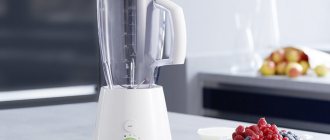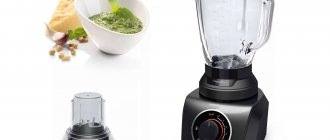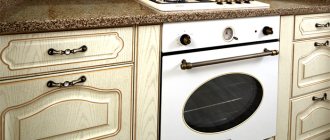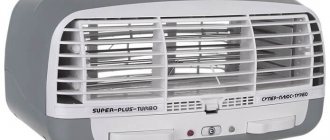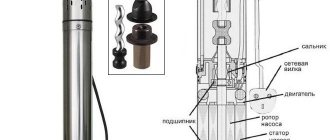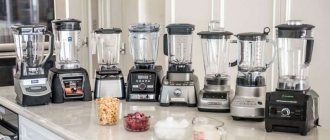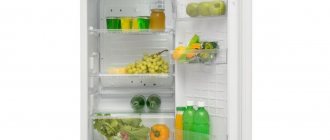What is it and what type of device is it?
A blender is a household kitchen appliance that allows you to quickly chop food, chop ice, prepare puree or sauce, whip up a drink or mousse. Blenders can be stationary or submersible .
A stationary blender is placed on the table, works quite autonomously, requires minimal control, an immersion blender - you need to hold it in your hands when working, requires direct human participation, you cannot put it on the table (with rare exceptions), you can only put it down.
They also differ in the placement of products relative to the kitchen appliance itself . With a stationary blender, products and ingredients are placed inside it; with an immersion blender, on the contrary, the blender is placed inside a container with products.
There is one device, but there are two varieties of it. Which one is suitable for a particular kitchen job and which one won't? Which blender should I use to prepare a large volume of drink, and which blender should I use to prepare a portion of baby puree for my child’s lunch? Which device should you buy for daily use, and which one for occasional use? Let's try to find out.
What is a blender and what do you eat it with?
First, let's define what a blender is and why, in principle, it is needed in the household. The blender is designed for grinding or mixing products of various properties: ice , nuts, minced meat, dough, eggs, etc.
You say, what about the mixer, food processor and meat grinder? What's wrong with them? Let's figure it out. The mixer only mixes the ingredients, and the meat grinder only grinds (besides, it is very massive and has a complex design). Harvesters take up a lot of space and are also quite finicky to assemble and install, and how long does it take to clean the device...
Unlike its predecessors, the blender:
- more compact;
- it is more convenient to disassemble and wash;
- will cope with the task much faster (if we are talking about a high-quality device);
- much more powerful;
- multifunctional.
Proper selection of the device you need will ensure that its parts will not sit sadly alone in a box, but will work for you.
What is it needed for?
Using a stationary blender, you can process a fairly large volume of products, limited only by the volume of the bowl and the desire of the cook . In general, this device requires minimal human intervention; you just need to fill the bowl with the necessary ingredients, press the power button and, after processing the products, turn off the device in a timely manner.
But small quantities of food (for example, a few cloves of garlic) cannot be chopped using this type of electrical appliance. When choosing to buy this blender, you need to take into account that you will need to allocate a certain place on the kitchen table, or remove the bowl and store it disassembled in the kitchen cabinet, since this blender is quite large in height and will not fit entirely into every kitchen furniture.
Therefore, this type of appliance is recommended for those who prepare large portions for a large family or guests and have a spacious work surface in the kitchen..
Retail chains offer a wide selection of stationary blenders at a variety of prices. You can buy the device at a price from 1,000 to 20,000 rubles.
Cost depends on:
- Completeness.
- Power.
- Manufacturing material.
- Country of manufacture.
- Manufacturing companies.
- Product brand.
- Status and, accordingly, the seller’s markup.
But with an immersion blender you can prepare small portions of food - a glass of cocktail or a bowl of creamy soup. It can be used with replaceable attachments and in any container, not only those that are often sold complete with this type of blender.
It is quite compact and, having bought such a blender, you can easily put it on any kitchen shelf or hang it on the wall on a special holder, which is included in some models; it does not require much storage space.
If you often have to prepare small portions of purees, smoothies or cocktails (for example, there is a small child in the family), or the kitchen table is small, then buying this type of blender will be the right choice. A problem when using it may be the need to constantly hold the blender in your hands while working, in some cases this is tiring . The food processing process (with rare exceptions) is almost always accompanied by splashes.
This type of kitchen appliances is cheaper than stationary models and sells for prices ranging from 450 to 8,500 rubles. The cost is affected by the same pricing factors as for stationary blenders .
How to choose a blender by power
As when choosing many other types of household appliances, the power of the device is of great importance, since the cooking time and quality of food largely depend on it. The higher this indicator, the better. Devices with high power are more expensive, but they fully justify the investment made, since just a few minutes after turning on the device, the dish will be ready.
Powerful blenders can easily handle frozen foods. If your goal is to purchase a device with greater functionality, it is best to give preference to models with a power of 800-1500 W.
Immersion blender
An immersion blender is a hand-held kitchen appliance with an elongated body with an electric motor built inside, control buttons on one end and paddle blades on the other. Often included with this device are several varieties of such knives and devices, built into interchangeable attachments for the blender handle and a chopper attachment, a container similar to a glass with knives inside and a special lid to which you can attach a blender.
The undeniable advantages of an immersion blender include:
- Mobility, it can work anywhere there is a power supply and in any container.
- There are models of immersion blenders that run on batteries, which allows you to move around the kitchen or house when preparing a dish without being tied to an electrical outlet (battery life is limited to 20-30 minutes and the device must be charged frequently). This feature of a wireless device is indispensable if you need to monitor small children.
- Immersion blenders are easy to maintain and easy to clean.
- They can be prepared for work simply and quickly.
- During the cooking process, you can change the angle of the device, thereby changing the position of the knives, if necessary.
This type of blender is ideal for preparing small portions of food, but if you try to use it in a large volume of prepared food, you may fail and not get the desired result.
Also, the disadvantages of immersion blenders include:
- The need to hold it in your hand and press the button constantly during the cooking process.
- Short operating time of wireless models.
- Splashes during operation.
- It is difficult to obtain a uniform consistency of the prepared dish, especially if it is prepared in a large container.
The ability to cook various products depends on several characteristics - for example, power and rotation speed. The power of immersion blenders can be from 120 to 1500 W, and the higher it is, the wider the list of products that can be processed using this electrical appliance, the longer the duration of operation without interruption, the faster the dish is prepared . The rotation speed of modern devices varies from 10,000 to 19,000 rpm, and the number of speeds for different models can be from 1 to 25.
Most models have a speed control feature. By turning a special regulator, or increasing and decreasing pressure on the button, you can increase or decrease the speed of the device. Some models have a “Turbo mode” button, when turned on, the device starts working at full power, but this button can only be used for a very short time. The higher the rotation speed, the finer the grinding of the processed products.
The range of dishes that can be prepared using an immersion blender is incredibly wide.:
- Sauces.
- Puree soups.
- Batter, for example for pancakes.
- Minced meat or fish.
- Pates.
- Salads.
- Cocktails and smoothies.
- Vegetable puree or stew.
- Baby food in the form of puree from any ingredients.
- You can chop nuts, garlic, spices, ice or herbs, frozen foods.
Operating modes
We found out that there are different types of blenders. But they also have something in common - operating modes. Let's look at this in a little more detail:
- Self-cleaning – this mode allows you to quickly and easily clean the blender bowl. What should be done? Simply fill the container with water and press the appropriate button.
- Pulse . Maybe you're having a party and you're planning on making cocktails with ice? This mode will allow you to crush hard objects such as ice and crackers.
- Turbo mode . With this mode, knives and other attachments begin to rotate even faster, which directly affects the speed of work.
- Vacuum pump . Do you want your food to stay fresh longer? Then this mode is for you. The vacuum pulls all the air out of the bowl.
- Foaming . To get a drink with a pleasant foam, just turn on this mode and wait a few minutes.
Thanks to these modes, you can surprise not only yourself, but also please your friends.
Stationary blender
A stationary blender consists of an electric motor - a blender drive, built into a stable housing, on top of which is placed a narrow, high bowl, similar to a jug with a pusher and a lid. Inside the bowl there is a paddle knife, which, when the electric motor is turned on, chops the products placed in it .
There is a type of blender - a blender-soup maker with a built-in heating element. Such a kitchen appliance can, in addition to chopping food, cook porridge, soup and grind its ingredients into puree; with its help you can prepare meat or liver pate, cook, and not just mix sauce or vegetable mousse. This type of blender is available exclusively with a metal bowl, which, after preparing a hot dish, retains heat for several hours .
The equipment for stationary blenders can be different - from the simplest, consisting of a base and one bowl, to the presence in the set of millers, juicers, whisks, interchangeable knives of different designs with different numbers of blades, several interchangeable bowls in which you can both cook and store prepared dishes and drinks, which of course is the advantage of such models.
The advantages of stationary blender models also include:
- Independent work, they do not need to be held in your hands.
- Convenient preparation of large volumes of dishes.
- Grinding of products is carried out in a closed container, without splashing, which is why the kitchen remains clean.
- Easy to use.
- The presence of an overheat protection function, thanks to which the device automatically turns off if a dangerous situation occurs.
- Thanks to the self-cleaning function, maintaining the blender is easy.
The disadvantage is that the device can only operate in a special container; if it is lost or damaged, the blender will not be able to operate.
Also, this type of blender is quite noisy, the sounds produced can be unpleasant for others, this feature of the device is also its disadvantage.
Sometimes the need for a separate place on the table is considered a drawback of the device, but a blender model that matches the design of the kitchen environment can serve as its decoration, so this feature should not be considered a negative feature.
Various models of stationary blenders are sold with bowls of different sizes, from 0.3 to 2.0 liters. The larger the capacity of the blender bowl, the greater the amount of food that can be processed in one go, which is important if dishes are prepared for a large number of people.
Bowls are made from various materials; very often they have a measuring scale for ease of use.
- The strongest ones are metal containers, and they are also the most durable.
- Next in terms of performance are bowls made of tempered impact-resistant glass. They can withstand high temperatures and do not absorb odors at all, but if dropped or hit, they can break.
- The cheapest option is plastic containers. They do not break, but gradually, during use, they become covered with small scratches and become cloudy.
Stationary blenders differ in engine power, on which the capabilities of the device depend, and in the number of revolutions. Modern devices are available with power from 200 to 3000 W, speed up to 35,000 rpm, which can be smoothly adjusted using a special knob on the body . The more powerful the device, the greater its ability to process products, the longer it can work without interruption.
Using a stationary blender you can prepare, and in considerable quantities:
- Sauces and gravies.
- Puree soups.
- Juice from crushed vegetables or fruits using a special nozzle.
- Milk or fruit shake.
- Smoothie.
- Homemade mayonnaise.
With some experience in use, you can prepare salads; if experience is not enough, you can prepare vegetable stew or puree. A powerful device can crush ice, grind hard spices or fruits.
Rotation speeds above 24,000 rpm make it possible to achieve an emulsification effect, in which the smallest particles of ingredients that normally do not mix with each other (for example, oil and water) are evenly mixed and it is possible to prepare sauces or pastry creams that are resistant to separation and do not disintegrate into components over time. .
What is an immersion blender?
The immersion blender is easy to use and requires virtually no assembly. It consists of a bowl and also a handle in which the motor is built. A wire comes from the handle - it is connected to the power supply. Operation is based solely on mechanical action - the user takes the handle and independently rotates it along the working surface inside the bowl. Manipulations may vary depending on what needs to be done - whipping liquids or cutting solid products.
Tip: for each dish you need to use its own special attachment!
You can also mix all the ingredients in a hand blender and add them one by one. Manual is especially suitable for those who like to change different modes and prepare dishes consisting of different components. However, the downside is the need to frequently redo the work - it often turns out that the consistency of the resulting product is not uniform and subsequently needs to be ground again.
Features of the submersible device, specifics of work, scope of application
Immersion is often used for working with liquid mixtures; it is perfect for creating cocktails and smoothies, ice cream, and creams. With its help, you can better, quickly and easily mix several types of liquid products;- The peculiarity of the work is that the submersible does not process the corner elements of the bowl well. It has a rounded shape, but the knives do not reach the edges, and large pieces of solid ingredients of the dish can accumulate there.
